Tracing the Bioavailability of Three-Dimensional Graphene Foam in Biological Tissues
Abstract
:1. Introduction
2. Results and Discussion
 ) was found in the fish heart treated with medium dose (Figure 7c) due to the deposition of pale golden brown (
) was found in the fish heart treated with medium dose (Figure 7c) due to the deposition of pale golden brown (  ) (lipofuscin) granules in the heart muscle fibers. Common carp treated with a high dose showed degeneration of muscle fibers (*), vacuolization and thin fibers (Figure 7d). Figure 7e–h show micrographs of the kidney of common carp treated with different doses of GF. Normal histology of the kidney was observed in the control and low dose treated groups (Figure 7e,f). Atrophy and degeneration of glomerulus was found in the medium treated group (Figure 7g). Necrosis and degeneration (ϕ) of kidney tubules was found in the high dose treated group (Figure 7h). Normal histology of the fish liver was found in the control and low dose treated groups (Figure 7i,j) while degeneration of hepatocytes (#), pyknosis, karyolysis, and karyorrhexis in nuclei of hepatocytes and degeneration of the central vein in the liver lobule of common carp were found in the medium dose treated groups. High levels of hepatocytes degeneration (λ), karyorrhexis, and haemorrhage were also found in liver lobule of fish treated with a high dose of GF (l). The respective histopathological alterations in these vital tissues of both control and treated groups (Figure 7) are given in Table S1. Histological alterations in these organs after 5 days of GF treatment are also shown in Figure S3 and Table S2.
) (lipofuscin) granules in the heart muscle fibers. Common carp treated with a high dose showed degeneration of muscle fibers (*), vacuolization and thin fibers (Figure 7d). Figure 7e–h show micrographs of the kidney of common carp treated with different doses of GF. Normal histology of the kidney was observed in the control and low dose treated groups (Figure 7e,f). Atrophy and degeneration of glomerulus was found in the medium treated group (Figure 7g). Necrosis and degeneration (ϕ) of kidney tubules was found in the high dose treated group (Figure 7h). Normal histology of the fish liver was found in the control and low dose treated groups (Figure 7i,j) while degeneration of hepatocytes (#), pyknosis, karyolysis, and karyorrhexis in nuclei of hepatocytes and degeneration of the central vein in the liver lobule of common carp were found in the medium dose treated groups. High levels of hepatocytes degeneration (λ), karyorrhexis, and haemorrhage were also found in liver lobule of fish treated with a high dose of GF (l). The respective histopathological alterations in these vital tissues of both control and treated groups (Figure 7) are given in Table S1. Histological alterations in these organs after 5 days of GF treatment are also shown in Figure S3 and Table S2.3. Materials and Methods
3.1. Fabrication and Characterization of Three-Dimensional GF
3.2. Procedure for In Vivo Toxicity
3.3. Measurement of Enzymatic Activity and Other Biochemical Parameters
4. Conclusions
Supplementary Materials
Acknowledgments
Author Contributions
Conflicts of Interest
References
- Nardecchia, S.; Carriazo, D.; Ferrer, M.L.; Gutiérrez, M.C.; del Monte, F. Three dimensional macroporous architectures and aerogels built of carbon nanotubes and/or graphene: Synthesis and applications. Chem. Soc. Rev. 2013, 42, 794–830. [Google Scholar] [CrossRef] [PubMed]
- Chen, Z.; Ren, W.; Gao, L.; Liu, B.; Pei, S.; Cheng, H.M. Three-dimensional flexible and conductive interconnected graphene networks grown by chemical vapor deposition. Nat. Mater. 2011, 10, 424–428. [Google Scholar] [CrossRef] [PubMed]
- Jiang, L.; Fan, Z. Design of advanced porous graphene materials: From graphene nanomesh to 3D architectures. Nanoscale 2014, 6, 1922–1945. [Google Scholar] [CrossRef] [PubMed]
- Wu, Z.S.; Sun, Y.; Tan, Y.Z.; Yang, S.; Feng, X.; Müllen, K. Three-dimensional graphene-based macro-and mesoporous frameworks for high-performance electrochemical capacitive energy storage. J. Chem. Soc. A 2012, 134, 19532–19535. [Google Scholar] [CrossRef] [PubMed]
- Singh, E.; Chen, Z.; Houshmand, F.; Ren, W.; Peles, Y.; Cheng, H.M.; Koratkar, N. Superhydrophobic graphene foams. Small 2013, 9, 75–80. [Google Scholar] [CrossRef] [PubMed]
- Zhang, X.; Liu, D.; Yang, L.; Zhou, L.; You, T. Self-assembled three-dimensional graphene-based materials for dye adsorption and catalysis. J. Mater. Chem. A 2015, 3, 10031–10037. [Google Scholar] [CrossRef]
- Luo, J.; Liu, J.; Zeng, Z.; Ng, C.F.; Ma, L.; Zhang, H.; Lin, J.; Shen, Z.; Fan, H.J. Three-dimensional graphene foam supported Fe3O4 lithium battery anodes with long cycle life and high rate capability. Nano Lett. 2013, 13, 6136–6143. [Google Scholar] [CrossRef] [PubMed]
- Patil, U.; Lee, S.C.; Kulkarni, S.; Sohn, J.S.; Nam, M.S.; Han, S.; Jun, S.C. Nanostructured pseudocapacitive materials decorated 3D graphene foam electrodes for next generation supercapacitors. Nanoscale 2015, 7, 6999–7021. [Google Scholar] [CrossRef] [PubMed]
- Dong, X.; Ma, Y.; Zhu, G.; Huang, Y.; Wang, J.; Chan-Park, M.B.; Wang, L.; Huang, W.; Chen, P. Synthesis of graphene–carbon nanotube hybrid foam and its use as a novel three-dimensional electrode for electrochemical sensing. J. Mater. Chem. 2012, 22, 17044–17048. [Google Scholar] [CrossRef]
- Li, N.; Zhang, Q.; Gao, S.; Song, Q.; Huang, R.; Wang, L.; Liu, L.; Dai, J.; Tang, M.; Cheng, G. Three-dimensional graphene foam as a biocompatible and conductive scaffold for neural stem cells. Sci. Rep. 2013, 3, 1604. [Google Scholar] [CrossRef] [PubMed]
- Shi, J.L.; Wang, H.F.; Zhu, X.; Chen, C.M.; Huang, X.; Zhang, X.D.; Li, B.Q.; Tang, C.; Zhang, Q. The nanostructure preservation of 3D porous graphene: New insights into the graphitization and surface chemistry of non-stacked double-layer templated graphene after high-temperature treatment. Carbon 2016, 103, 36–44. [Google Scholar] [CrossRef]
- Wang, J.K.; Xiong, G.M.; Zhu, M.; Özyilmaz, B.; Castro Neto, A.H.; Tan, N.S.; Choong, C. Polymer-enriched 3D graphene foams for biomedical applications. ACS Appl. Mater. Interfaces 2015, 7, 8275–8283. [Google Scholar] [CrossRef] [PubMed]
- Nieto, A.; Dua, R.; Zhang, C.; Boesl, B.; Ramaswamy, S.; Agarwal, A. Three dimensional graphene foam/polymer hybrid as a high strength biocompatible scaffold. Adv. Funct. Mater. 2015, 25, 3916–3924. [Google Scholar] [CrossRef]
- Schultz, A.G.; Boyle, D.; Chamot, D.; Ong, K.J.; Wilkinson, K.J.; McGeer, J.C.; Sunahara, G.; Goss, G.G. Aquatic toxicity of manufactured nanomaterials: Challenges and recommendations for future toxicity testing. Environ. Chem. 2014, 11, 207–226. [Google Scholar] [CrossRef]
- Köprücü, K.; Aydın, R. The toxic effects of pyrethroid deltamethrin on the common carp (Cyprinus carpio L.) embryos and larvae. Pestic. Biochem. Phys. 2004, 80, 47–53. [Google Scholar] [CrossRef]
- Yu, Q.; Lian, J.; Siriponglert, S.; Li, H.; Chen, Y.P.; Pei, S.S. Graphene segregated on Ni surfaces and transferred to insulators. Appl. Phys. Lett. 2008, 93, 113103. [Google Scholar] [CrossRef]
- Paronyan, T.M.; Thapa, A.K.; Sherehiy, A.; Jasinski, J.B.; Jangam, J.S.D. Incommensurate Graphene Foam as a High Capacity Lithium Intercalation Anode. Sci. Rep. 2017, 7, 39944. [Google Scholar] [CrossRef] [PubMed]
- Ferrari, A.C.; Meyer, J.C.; Scardaci, V.; Casiraghi, C.; Lazzeri, M.; Mauri, F.; Piscanec, S.; Jiang, D.; Novoselov, K.S.; Roth, S.; et al. Raman spectrum of graphene and graphene layers. Phys. Rev. Lett. 2006, 97, 187401. [Google Scholar] [CrossRef] [PubMed]
- Janowska, I.; Vigneron, F.; Bégin, D.; Ersen, O.; Bernhardt, P.; Romero, T.; Ledoux, M.J.; Pham-Huu, C. Mechanical thinning to make few-layer graphene from pencil lead. Carbon 2012, 50, 3106–3110. [Google Scholar] [CrossRef]
- Seabra, A.B.; Paula, A.J.; de Lima, R.; Alves, O.L.; Duran, N. Nanotoxicity of graphene and graphene oxide. Chem. Res. Toxicol. 2014, 27, 159–168. [Google Scholar] [CrossRef] [PubMed]
- Reuter, S.; Gupta, S.C.; Chaturvedi, M.M.; Aggarwal, B.B. Oxidative stress, inflammation, and cancer: How are they linked? Free Radic. Biol. Med. 2010, 49, 1603–1616. [Google Scholar] [CrossRef] [PubMed]
- Sanfeliu, C.; Sebastià, J.; Kim, S.U. Methylmercury neurotoxicity in cultures of human neurons, astrocytes, neuroblastoma cells. Neurotoxicology 2001, 22, 317–327. [Google Scholar] [CrossRef]
- AshaRani, P.V.; Low Kah Mun, G.; Hande, M.P.; Valiyaveettil, S. Cytotoxicity and genotoxicity of silver nanoparticles in human cells. ACS Nano 2008, 3, 279–290. [Google Scholar] [CrossRef] [PubMed]
- Natarajan, V.; Wilson, C.L.; Hayward, S.L.; Kidambi, S. Titanium dioxide nanoparticles trigger loss of function and perturbation of mitochondrial dynamics in primary hepatocytes. PLoS ONE 2015, 10, e0134541. [Google Scholar] [CrossRef] [PubMed]
- Li, Z.H.; Zlabek, V.; Velisek, J.; Grabic, R.; Machova, J.; Randak, T. Responses of antioxidant status and Na+–K+-ATPase activity in gill of rainbow trout, Oncorhynchus mykiss, chronically treated with carbamazepine. Chemosphere 2009, 77, 1476–1481. [Google Scholar] [CrossRef] [PubMed]
- Perendija, B.R.; Despotović, S.G.; Radovanović, T.B.; Gavrić, J.P.; Mitić, B.S.; Pavlović, S.Z.; Ognjanović, B.I.; Simić, S.B.; Pajović, S.B.; Saičić, Z.S. Biochemical and ultrastructural changes in the liver of European perch (Perca fluviatilis L.) in response to cyanobacterial bloom in the Gruža Reservoir. Arch. Biol. 2011, 63, 979–989. [Google Scholar] [CrossRef]
- Kütter, M.T.; Romano, L.A.; Ventura-Lima, J.; Tesser, M.B.; Monserrat, J.M. Antioxidant and toxicological effects elicited by alpha-lipoic acid in aquatic organisms. Comp. Biochem. Physiol. C 2014, 162, 70–76. [Google Scholar] [CrossRef] [PubMed]
- Jos, A.; Pichardo, S.; Prieto, A.I.; Repetto, G.; Vázquez, C.M.; Moreno, I.; Cameán, A.M. Toxic cyanobacterial cells containing microcystins induce oxidative stress in exposed tilapia fish (Oreochromis sp.) under laboratory conditions. Aquat. Toxicol. 2005, 72, 261–271. [Google Scholar] [CrossRef] [PubMed]
- Zha, Y.; Chai, R.; Song, Q.; Chen, L.; Wang, X.; Cheng, G.; Tang, M.; Wang, M. Characterization and toxicological effects of three-dimensional graphene foams in rats in vivo. J. Nanopart. Res. 2016, 18, 1–2. [Google Scholar] [CrossRef]
- Liu, J.H.; Wang, T.; Wang, H.; Gu, Y.; Xu, Y.; Tang, H.; Jia, G.; Liu, Y. Biocompatibility of graphene oxide intravenously administrated in mice—Effects of dose, size and exposure protocols. Toxicol. Res. 2015, 4, 83–91. [Google Scholar] [CrossRef]
- Patlolla, A.K.; Randolph, J.; Kumari, S.A.; Tchounwou, P.B. Toxicity Evaluation of Graphene Oxide in Kidneys of Sprague-Dawley Rats. Int. J. Environ. Pub. Health 2016, 13, 380. [Google Scholar] [CrossRef] [PubMed]
- Chabi, S.; Peng, C.; Yang, Z.; Xia, Y.; Zhu, Y. Three dimensional (3D) flexible graphene foam/polypyrrole composite: Towards highly efficient supercapacitors. RSC Adv. 2015, 5, 3999–4008. [Google Scholar] [CrossRef]
- Chabi, S.; Chang, H.; Xia, Y.; Zhu, Y. From graphene to silicon carbide: Ultrathin silicon carbide flakes. Nanotechnology 2016, 27, 075602. [Google Scholar] [CrossRef] [PubMed]
- Jabeen, F.; Chaudhry, A.S. Effects of cadmium chloride and sodium selenite alone or in combination on the liver of male Sprague–Dawley rats assessed by different assays. Biol. Trace Elem Res. 2011, 143, 1077–1090. [Google Scholar] [CrossRef] [PubMed]
- Lee, J.S. Effects of soy protein and genistein on blood glucose, antioxidant enzyme activities, and lipid profile in streptozotocin-induced diabetic rats. Life Sci. 2006, 79, 1578–1584. [Google Scholar] [CrossRef] [PubMed]
- Zor, T.; Selinger, Z. Linearization of the Bradford protein assay increases its sensitivity: Theoretical and experimental studies. Anal. Biochem. 1996, 236, 302–308. [Google Scholar] [CrossRef] [PubMed]
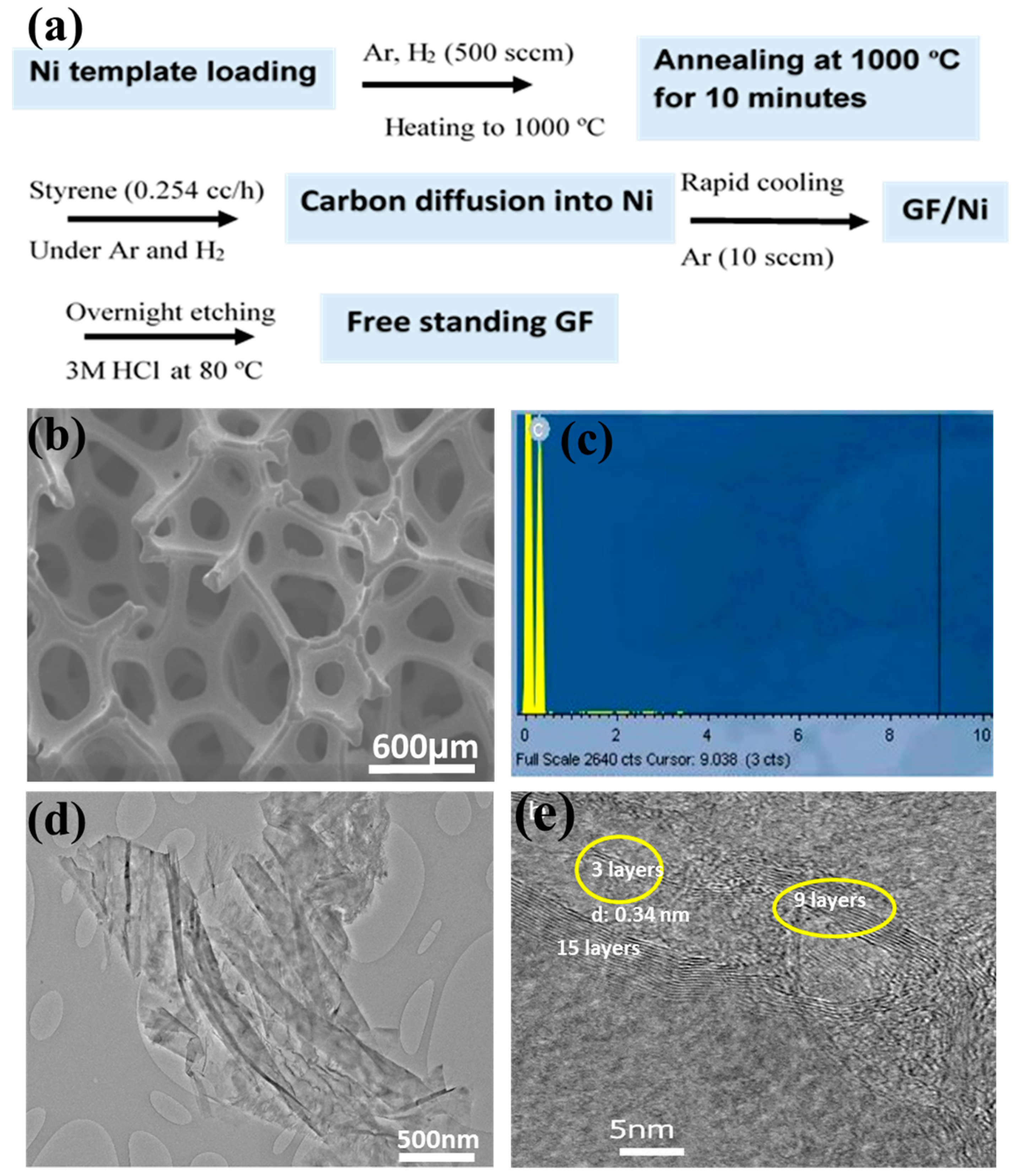

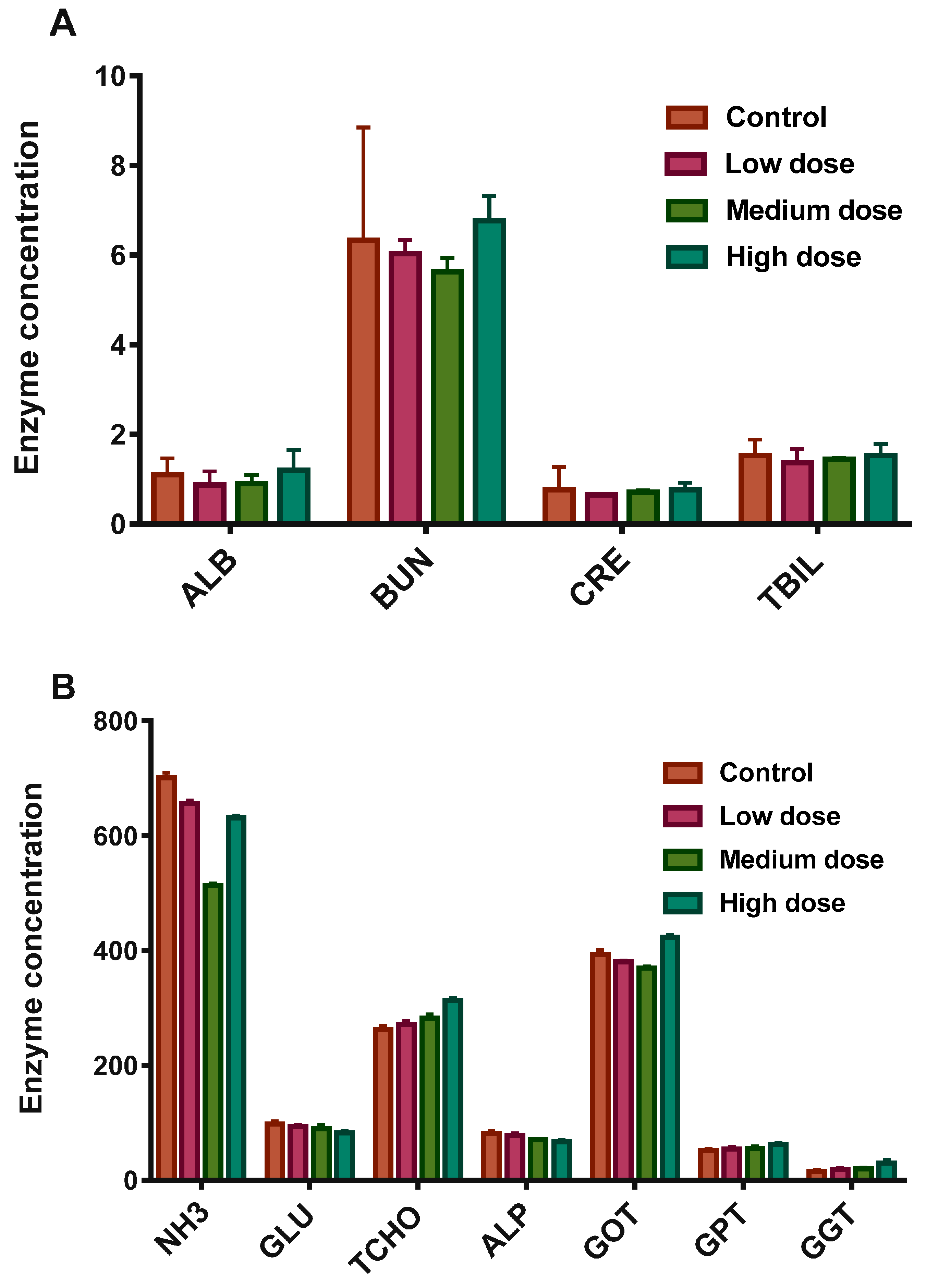
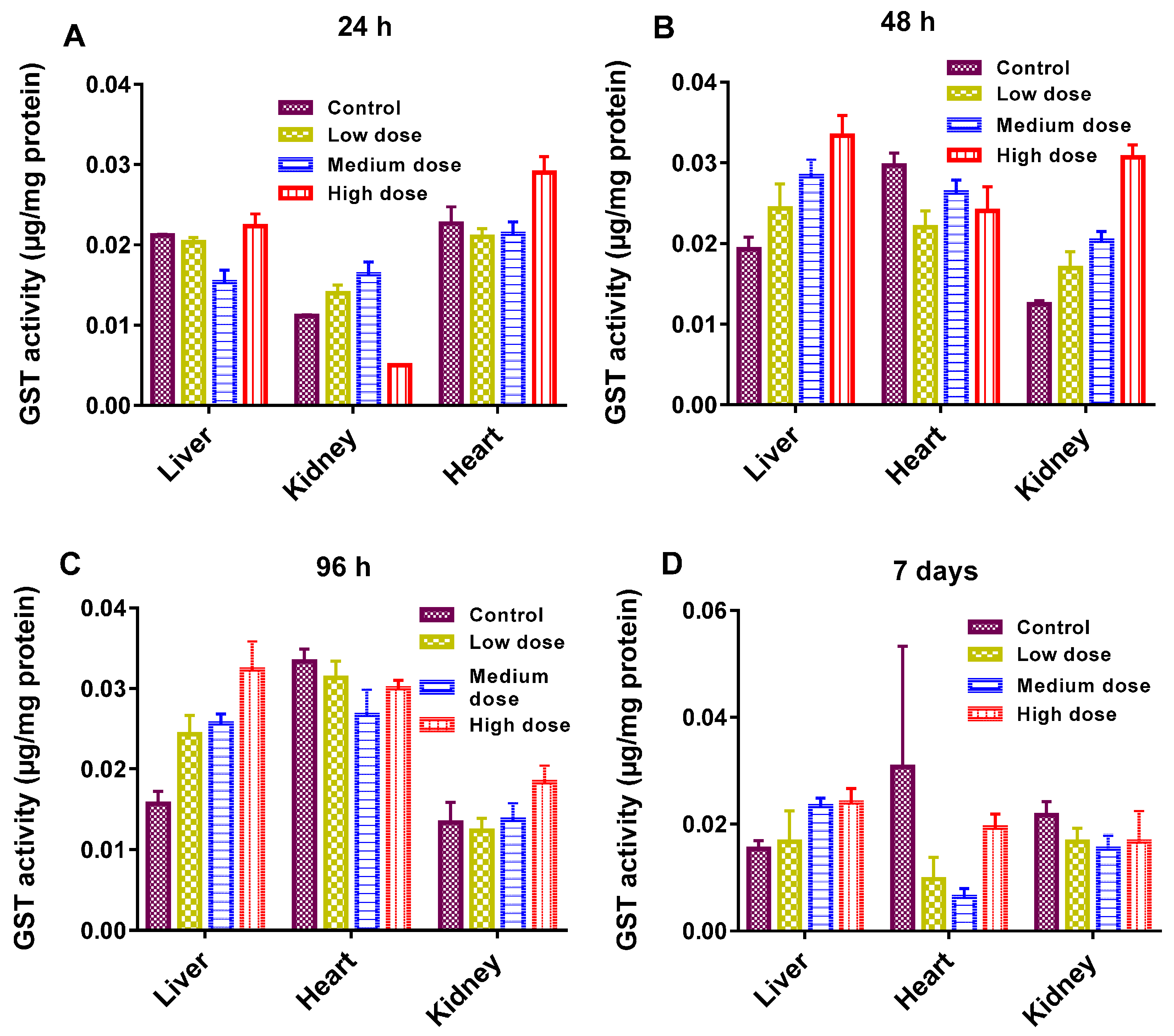
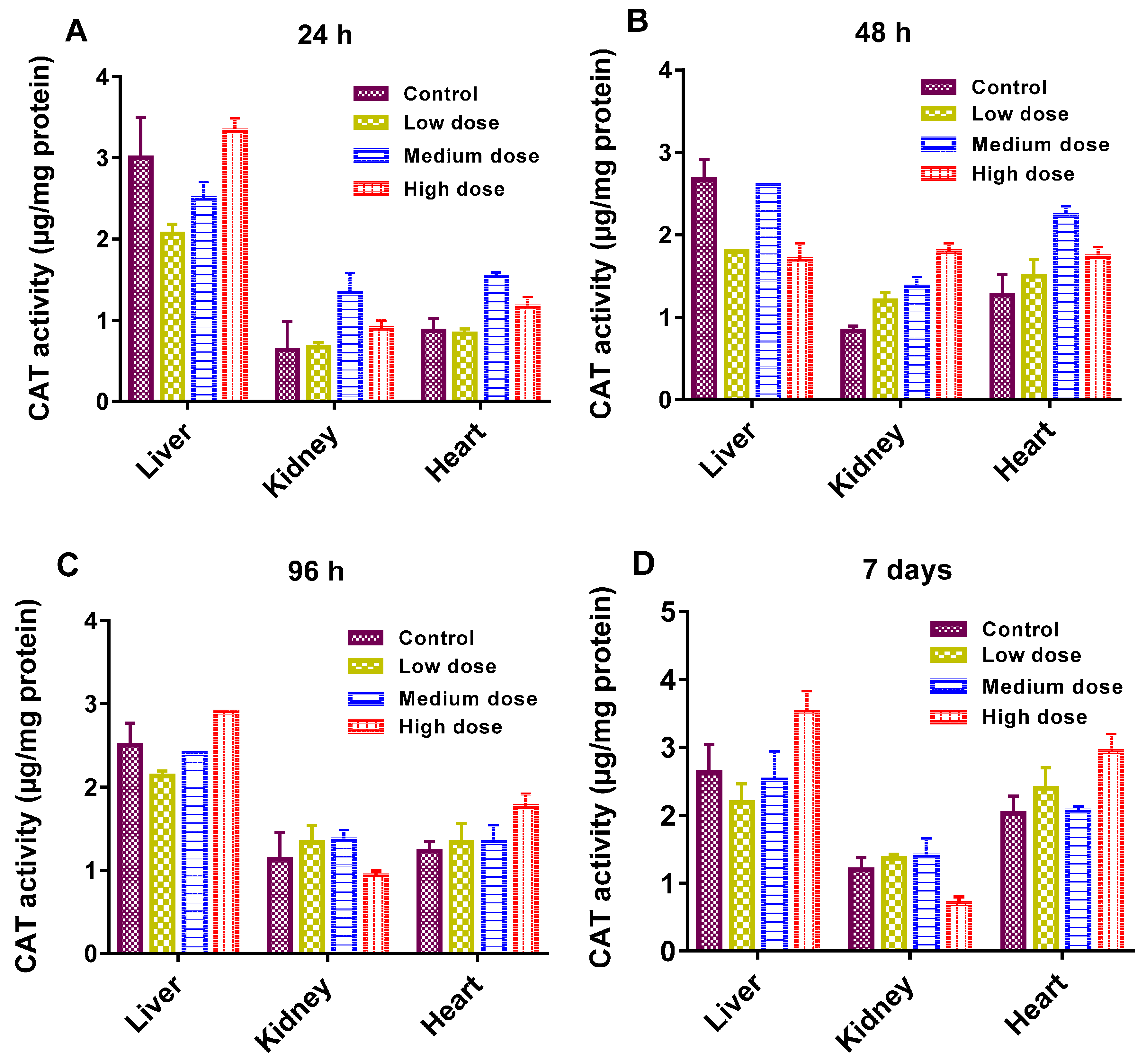
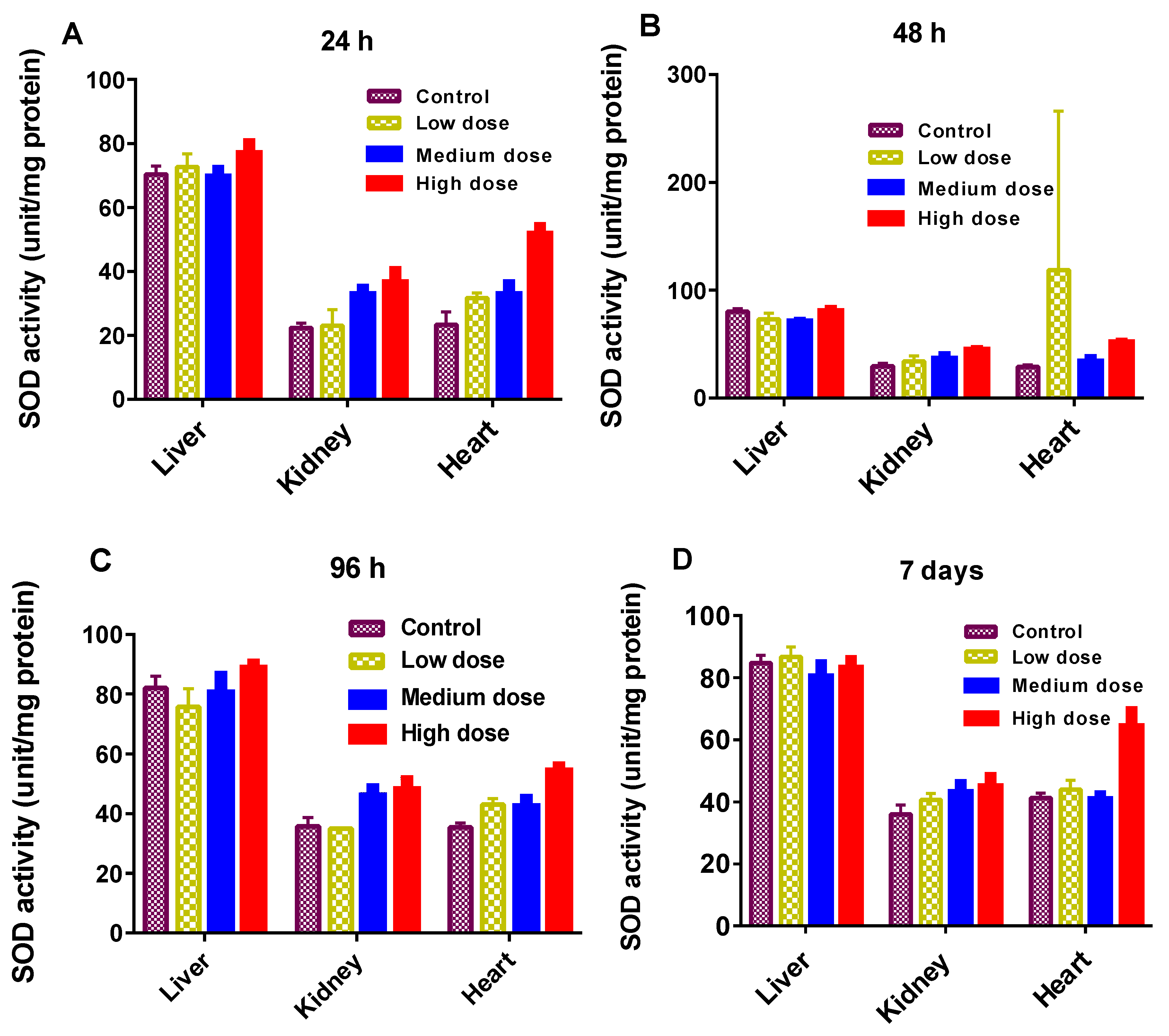

© 2017 by the authors. Licensee MDPI, Basel, Switzerland. This article is an open access article distributed under the terms and conditions of the Creative Commons Attribution (CC BY) license (http://creativecommons.org/licenses/by/4.0/).
Share and Cite
Tabish, T.A.; Chabi, S.; Ali, M.; Xia, Y.; Jabeen, F.; Zhang, S. Tracing the Bioavailability of Three-Dimensional Graphene Foam in Biological Tissues. Materials 2017, 10, 336. https://doi.org/10.3390/ma10040336
Tabish TA, Chabi S, Ali M, Xia Y, Jabeen F, Zhang S. Tracing the Bioavailability of Three-Dimensional Graphene Foam in Biological Tissues. Materials. 2017; 10(4):336. https://doi.org/10.3390/ma10040336
Chicago/Turabian StyleTabish, Tanveer A., Sakineh Chabi, Muhammad Ali, Yongde Xia, Farhat Jabeen, and Shaowei Zhang. 2017. "Tracing the Bioavailability of Three-Dimensional Graphene Foam in Biological Tissues" Materials 10, no. 4: 336. https://doi.org/10.3390/ma10040336




